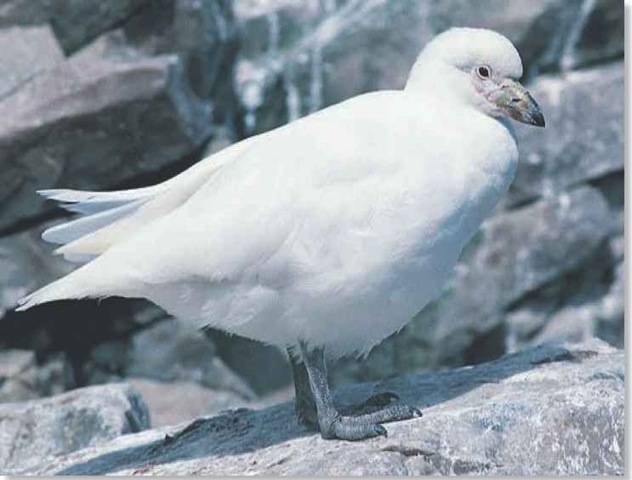ORDER
Charadriiformes
FAMILY
Chionidae
GENUS & SPECIES
KEY FEATURES
The ultimate refuse scavenger of the Antarctic; survives by eating anything remotely edible Lives by food-rich waters but does not swim or wade, so it has become expert at stealing food Usually found among penguins; times breeding with theirs to exploit feeding opportunities
WHERE IN THE WORLD?
Breeds on the Antarctic Peninsula and nearby islands, as far north as South Georgia; some birds overwinter in the Falkland Islands and South America

Lifecycle
The sturdy, robust sheathbill is a skilled thief, making its living by plundering food from penguin and seal colonies on gale-lashed shores in the southern Ocean.
Habitat
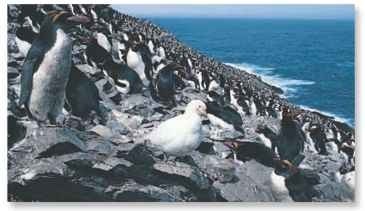
A Penguin pest Sheathbills typically infiltrate the colonies of many types of penguins.
The snowy sheathbill breeds on the Antarctic Peninsula and islands in the South Atlantic, where resident wildlife must endure freezing weather for at least ten months of the year With its super dense plumage, the sheathbill is well adapted to such hostile conditions. Nevertheless, many populations fly some 500 miles north after breeding to overwinter on the shores of the Falkland Islands or Patagonia in South America. They leave between March and July, returning in October and November (the southern spring).
Although it can be found on grassy inland bogs, the sheathbill usually keeps to the shore among penguin colonies. It may also be found on pack ice, especially when Weddell seals are pupping.
• The sheathbill is the only land bird that breeds on Antarctica’s shores.
# Unafraid of humans, the sheathbill may enter buildings to look for food.
• After the Falklands War, sheathbills were “stowaways” on returning English ships.
The sheathbill also steals food from nesting albatrosses and cormorants.
Breeding
The sheathbill normally pairs for life and breeds during the brief Antarctic summer. Pigeonlike head-bobbing forms an all-purpose display, used in disputes as well as courtship, and also as a greeting when a bird takes over incubation from its mate.
To ensure a good food supply, a pair almost always establishes its territory near, or among, a penguin colony. Living among the densely packed penguins also provides shelter The sheathbill noisily chases off rivals, but fights rarely amount to much.
The sheathbills build a nest from a smelly jumble of feathers, seaweed, shells and debris, usually in a crevice, and the female lays two or three creamy-white eggs. By the time they hatch a month late^the penguin chicks are also emerging.The parents take turns stealing food from penguins to feed their own young. Many
sheathbill chicks fall prey to skuas — or even to other sheathbills — and usually only one of the brood survives.
Protective mother A female often leaves chicks in a rock crevice.
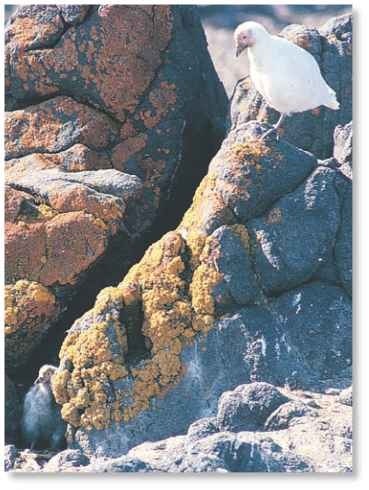
conservation
The snowy sheathbill has a stable population of around 10,000 pairs, with the highest number on South Orkney Island. At one time, it was killed for food by whaling crews, but nowadays it benefits from humans in the Antarctic. Some island birds no longer migrate in winter, thanks to the extra food provided by garbage from scientific research stations.
Behavior
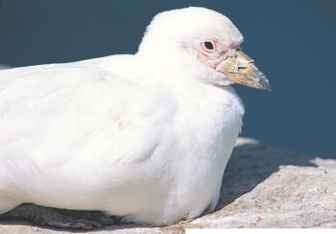
A Floor manager The sheathbill sticks mainly to the ground.
The sheathbill is notorious among locals. They know it as the “paddy,” and it often follows them as they take out garbage. It also grabs food from scientists studying penguins, and pecks at their clothing to see if it is worth eating.
The sheathbill flies strongly if migrating, but it is reluctant to take to the air otherwise. It prefers to strut around, like a chicken, and breaks into a run when threatened. Every day it bathes and preens to condition its plumage. It often hops on one leg, keeping the othertucked into its feathers, to reduce heat loss. The bird is generally silent except when disputing territories.
Food & feeding
As a landbird in a region where the sea is the main source of food, the sheathbill has devised ways to obtain food from aquatic predators. Adelie and chinstrap penguins are the main objects of its unwanted attentions, as it runs nimbly between their nests, looking for unguarded eggs or small chicks. It even steals straight from the mouths of chicks as they are being fed by their parents. But only the older and more experienced sheathbills try this trick on the formidable king penguin.
Anything nutritious is a source of food, including feces (right), molted feathers, and invertebrates. Even blood, obtained by pecking at the wounds of seals, is a food source.
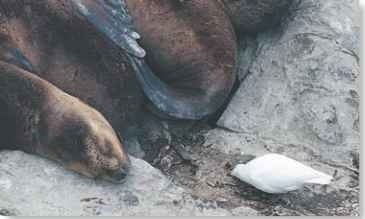
on the scrounge
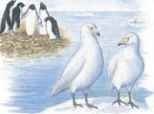
Cleaning contractors…
Sheathbills are often found near penguin colonies, where they eat droppings, eggs, chicks and food brought by adults.
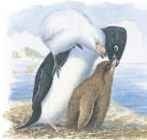
Shore thing…
On spotting a penguin regurgitating food for its chick, the sheathbill tries to distract the adult; then, it steals the spilled dinner.
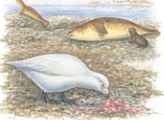
Waste recycling…
The afterbirth of a seal provides a feast for the sheathbill, which regularly forages near seal colonies during the pupping season.
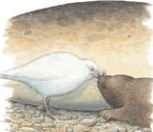
Milk thief
The bold sheathbill drinks the seal’s milk by inserting its bill between the mother’s nipple and the mouth of the pup.
PROFILE
Snowy Sheathbill
The sheathbill is essentially a wader that has adapted to spend most of its life on dry land. Luxuriantly thick plumage helps it brave bitter winters.
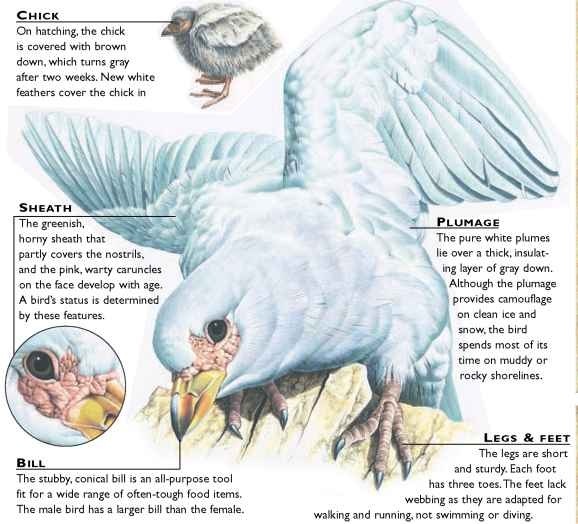
Creature comparisons
The south polar skua (Catharacta maccormicki) is heavier than the snowy sheathbill, and has a wingspan of about 4′. Whereas the sheathbill has pure white plumage, the south polar skua varies in color from dark brown to pale gray. Like the sheathbill, it breeds in loose colonies along the coast of Antarctica, and is highly territorial. While the sheathbill steals food from wildlife on i land, the south polar skua does the same in the air It chases terns and other birds until they drop or disgorge their catches of fish. Like the sheathbill, the skua eats penguins’ eggs and chicks.

Snowy sheathbill
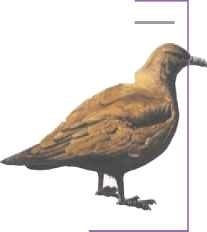
South polar skua
| VITAL STATISTICS Weight 16-27 oz. |
|
| Length | 13-16″ |
| Wingspan | 30-32″ |
| Sexual Maturity | 3-5 years |
| Breeding Season |
December -March |
| Number of Eggs |
Usually 2-3 |
| Incubation Period | 28-32 days |
| Fledging Period | 50-60 days |
| Typical Diet | Any animal matter, including carrion, feces, fish, eggs and chicks; also eats seaweed and human garbage |
| Lifespan | Unknown |
RELATED SPECIES
• The genus Chionis also includes the black-faced sheathbill, C. minor. Both species have white plumage, but the black-faced sheathbill has a black bill and face. Sheathbills share the order Charadriiformes with several families. These include gulls (Laridae), terns (Sternidae), and the skuas (Stercorariidae), which pillage over the world’s oceans.
